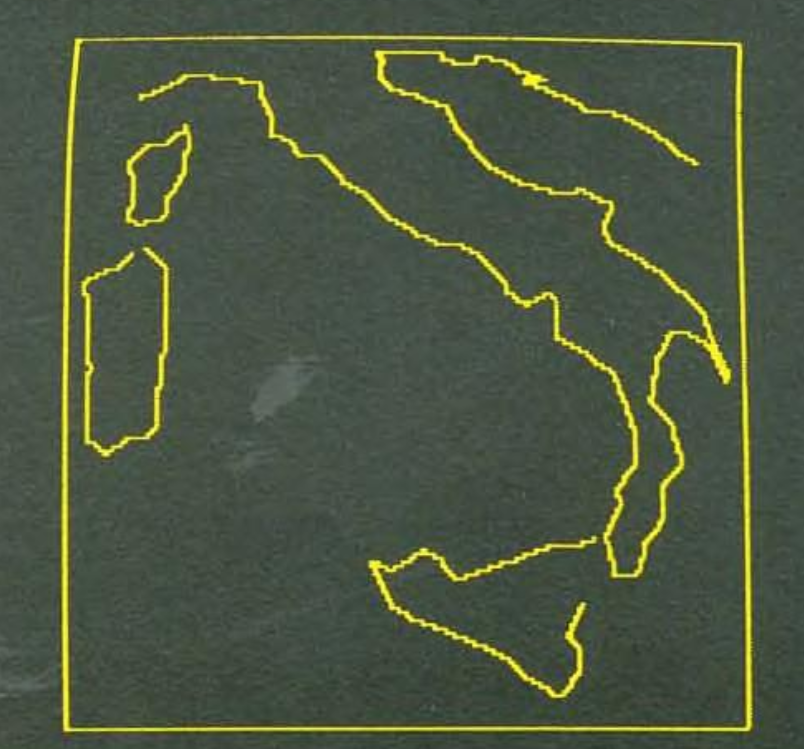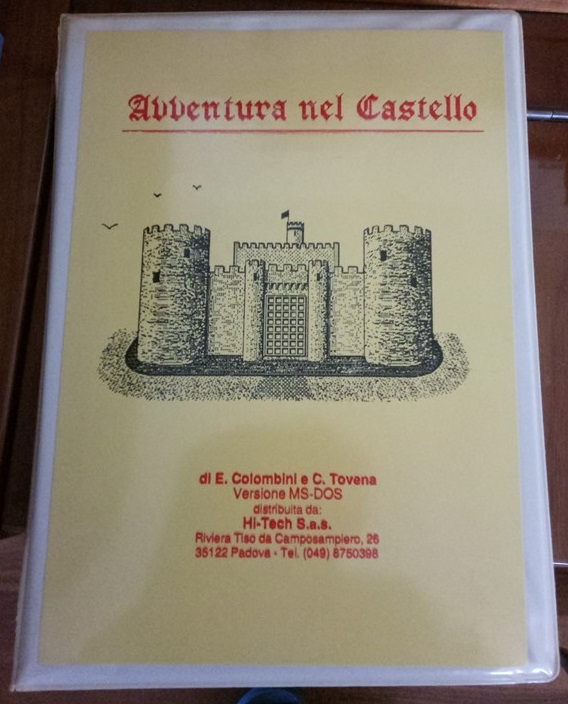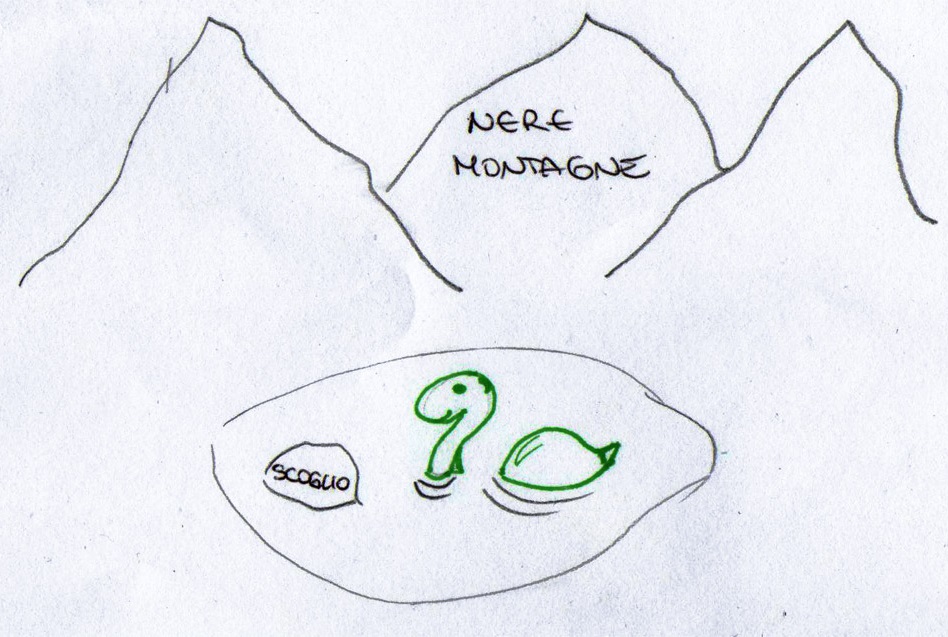It is in some ways mysterious that we haven’t had more adventure games in languages other than English.
Still, as we’ve seen from Australia and the UK, for adventures to be made there needs to be infrastructure in terms of number of computers in public hands, and companies willing to publish games. So while we have Acheton dating back to almost primeval days, and a single odd 1980 game for the UK101, we really don’t have UK adventures start going until 1981. For Australia, the only 1980 example we have is almost completely plagiarized from a game in a 1979 US magazine.
Alternately (or additively), a country may just not have had exposure to adventure games. They specifically might have missed the “mainframe wave” created by Crowther/Woods Adventure. Japan didn’t really have the adventure game concept “filter in” until Omotesando Adventure in 1982. (As presented in the magazine which printed it, adventures were a “New Type” of computer games.) They started their exposure with Mystery House and other Apple II imports instead of mainframe games.
In the case of Italy, they had local mainframes (even developing some back in the 1950s) and they were already well-established with home computer amateur development by 1980. Yet, it took until 1982 for an adventure game to appear.
A game that is essentially required to be played in English would not necessarily have made in-roads. For one of our authors today, Enrico Colombini, his first exposure to adventures was indeed the classic Adventure, but on a foreign mainframe (or at least mini-computer) and essentially by accident.
Enrico started the electronics store EC Elettronica in 1980 with his wife (Chiara, also a co-author on today’s game) and two of his friends; that same year they were exhibitors at a fair in Milan. They were setup near a Motorola stand with a “expensive looking” computer that was very large, and Enrico wandered over and read the iconic opening from the screen:
You are standing at the end of the road before a small brick building. Around you is a forest. A small stream flows out of the building and down a gully.
Since the booth workers didn’t mind, Enrico started typing, using his “rough English”. He “persi il senso del tempo”, that is, lost all sense of time. He eventually came to a sword planted in a rock making a humming sound, but had to stop when the fair closed. The sword in the rock is not from Crowther/Woods Adventure, but rather Adventure 550, with additions by David Platt. Once extracted, it actually sings when used on an ogre.
The sword halts in mid-air, twirls like a dervish, and chants several bars of “Dies Irae” in a rough tenor voice. It then begins to spin like a rip-saw blade and flies directly at the ogre, who attempts to catch it without success; it strikes him full on the chest.
However, Mr. Colombini never got to that part, because the adventure program was gone the next day.
EC Elettronica had a PET 2001 to keep track of company stock, which was eventually replaced with an Apple II (and disk drives). The computer was used for recreation in addition to work.
In quel periodo tutto era nuovo, e quasi ogni programma era interessante.
In this time period, everything was new and nearly every program was interesting.
Enrico came across a disk marked Apple Adventure, and found a game recognizably close to the one he had played, so was able (after some hacking to fix the save file mechanism) to play to the maximum 350 points. He credits it with teaching him English.

This is a straight port by Peter Schmuckal and Leonard Barshack, so I haven’t written about it before.
Enrico Colombini and his wife (Chiara Tovena) then embarked on writing their own game, self-publishing for Apple II early in 1982 under the name Dinosoft at a local shop in Pescia, creating “una confezione molto artigianale fatta con adesivi letraset“, that is, “a very artisanal package made with Letraset stickers”.
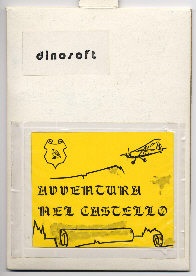
From the author, and unfortunately the largest image of this we have, but I guess it fits with the “artisanal” part.
Some “firsts” are obscure (like Bilingual Adventure), some are well-known and celebrated. Avventura nel Castello ended up being one of the legendary Italian games, and had multiple reprints: in 1984 for J. Soft (still Apple II), in 1987 for Hi-Tech (for DOS), in 1996 (independently, also for DOS) and finally in fancy modern form in 2021, including a translation into English (Castle Adventure).

Advertising for the J. Soft version. Via eBay.
I’ve been playing the English translation and cross-checking with the first Italian version for Apple II. I can say they are fairly close, and the original is just as wordy as the newer version is. This is Apple II, with a whopping 48K of memory, and the author — clearly thinking directly of Adventure — has the memory space and inclination to be wordier than Scott Adams.
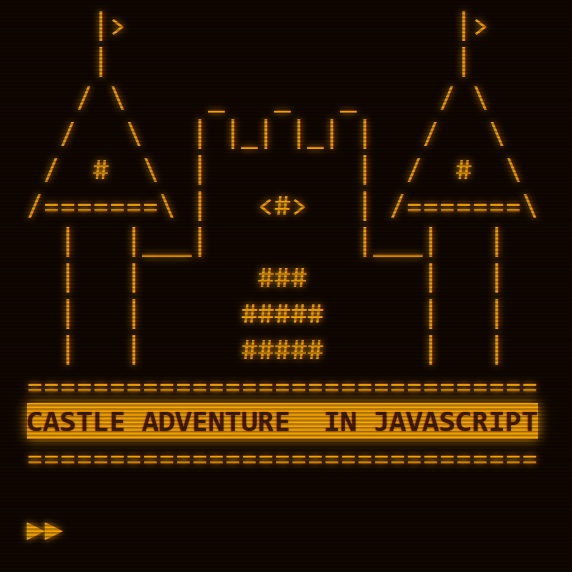
This opening genuinely is duplicating the original opening.
You’re piloting your single-seater over the desolate Highlands of Scotland.
You’ve just flown over Loch Ness…
Suddenly, the engine misfires.
The controls aren’t responding!
You’re plummeting!
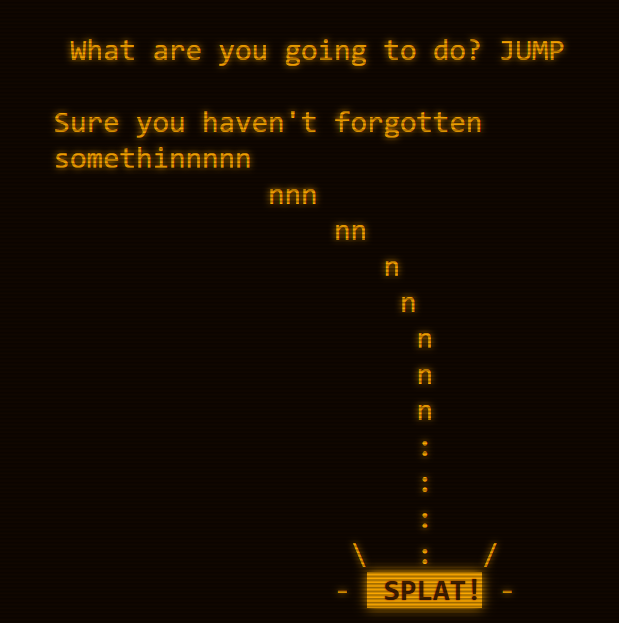
You’re supposed to guess the “aren’t you forgetting something” that there’s a parachute, and TAKE PARACHUTE (GET doesn’t work).
What are you going to do? TAKE PARACHUTE
Oh, look. There is a parachute. I hadn’t seen it.
I promise you that, from now on, I’ll be much more careful, and will
scrupulously report all the objects around you.
Anyway, you’ve got it on now.
You’re plummeting!
(This is probably the fairest “get an item that is not described in the room” puzzle we’ve seen in All the Adventures. The text cues what to do quite strongly. See Escape from Colditz for an unfair example.)
In Italian, the game wants PRENDI PARACADUTE.
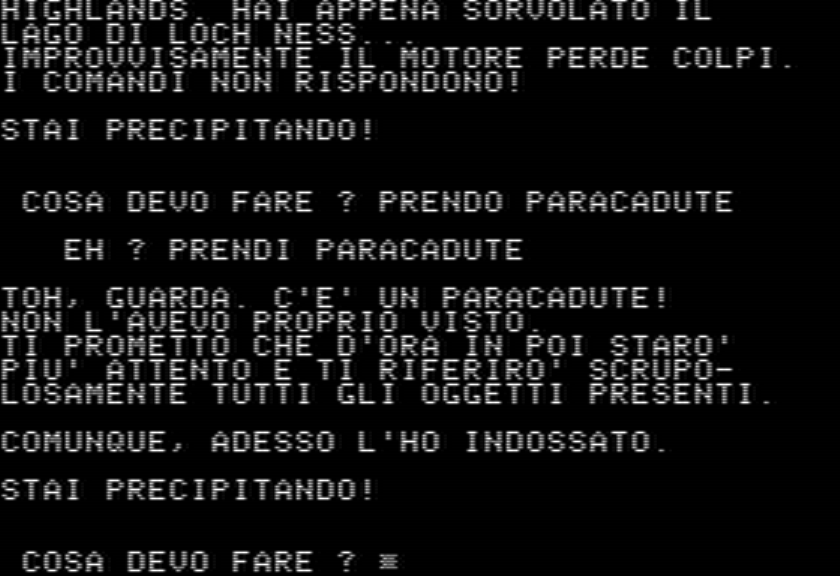
The conjugation is important. I struggled for a while because I was typing PRENDO PARACADUTE (“I take the parachute”) rather than PRENDI PARACADUTE (“You take the parachute”). This is the “I am your puppet” style perspective where you assume you are a step removed from your avatar. This can differ based on the norms of how a particular language approaches adventure games. I remember having a bewildered discussion with an Italian back in the 90s claiming saying “you” want to do something felt bizarre when “I” was the one in the story, but they were insistent that I was being the bizarre one.
This game also quite specifically wants the imperative. So the next step isn’t SALTO (thinking “I jump” in present tense) or SALTI (“you jump” in present tense) but rather SALTA, in imperative.
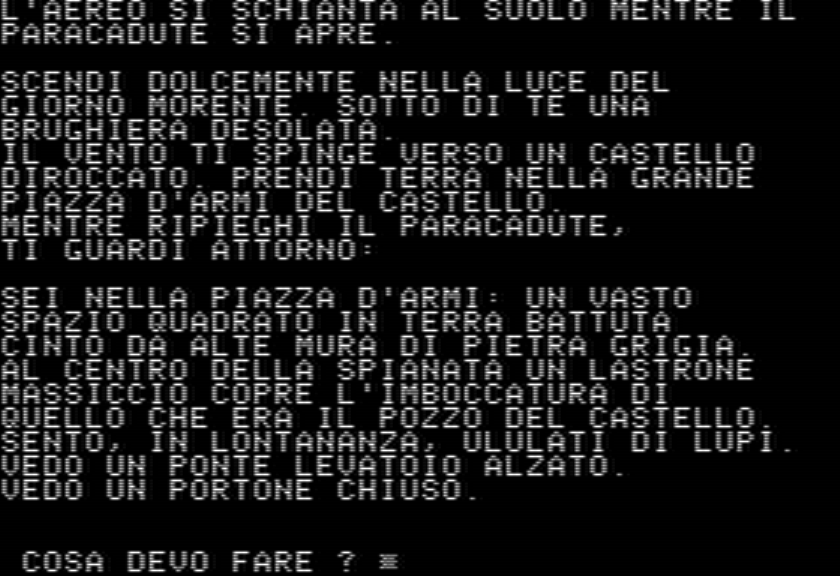
Switching back to English:
What are you going to do? JUMP
Just in time!
The plane crashes to the ground, as your parachute opens.
You gently descend in the dying daylight. Below you appears a desolate moor. The wind pushes you towards a ruined castle. You land in the castle’s large parade ground.
While you fold away your parachute, you look around:
You’re on the parade ground: a vast, square, beaten-earth clearing, surrounded by high, grey stone walls.
In the center of the courtyard, a massive slab covers the mouth of the castle’s well.
In the distance, you can hear the howling of wolves.
I can see a raised drawbridge.
I can see a closed door.
There’s not much we can do with the massive slab or drawbridge (I think) so the only way to make progress now is to open the door and go in the castle.
What are you going to do? ENTER DOOR
The door slams shut, without leaving the slightest crack.
You are in a large atrium, immersed in darkness. An eerie phosphorescence emanating from the walls allows you to just about distinguish the contours of the room.
A marble staircase rises upwards, dimly lit by the greenish light, but gradually disappearing into the darkness.
I can see a coat of arms painted on the ceiling.
Here we are trapped, and now our main objective is to escape.
My map so far, just of the ground:

It’s nearly all accessible and peaceful, and even though there’s some vivid descriptions, sort of sparse. This game is not trying to stuff itself with items. That might mean there are enough floors that we get lots of items, or it might just mean there’s hidden things. I’m going with the presumption that anything in the room description can’t really be used and only the items that get listed after are important, but if I get seriously stuck I’ll reconsider.
First, a tour of the ground floor, then a quick trip to the basement, and then I’ll show off the maze on the second floor.
You’re in a large living room, furnished with numerous sofas and comfortable armchairs. In the centre of one wall is a monumental fireplace, built with blocks of carved stone.
Although the fire has been out for centuries, the room still seems to be illuminated by a wavering reddish light.
I can see a cat crouched on the ground.
Using the presumption I just spoke of, the sofas and fireplace don’t need to be fiddled with, but the cat is important. You can feed the cat some milk from the kitchen, and then can pick it up. I haven’t found any birds or mice to sic it on yet, though.
Elsewhere:
You’re in an elongated room without any furniture. The walls are lined with portraits of clan chiefs, lairds and dignitaries who have governed the castle and lands over centuries.
The portraits seem to stare at you with malevolent eyes. One in particular, that of MacCallum IV, seems to follow your movements with a gaze full of murderous hatred.
This feels like it is just meant to be lore. You can’t move the portrait or take it. While I’m at it, though…
What are you going to do? PULL PORTRAIT
Gonnae no dae that. I’d prefer not.
…does the Italian actually attempt the equivalent of a Scottish accent? That’s past my pay grade (or rather, my dimly-remembered college Italian).
Other map highlights include:
- a rampart that you can walk around, where you can see fog and hear “cawing of the crows”
- a mirror room that takes a little while to exit because you can accidentally run into a mirror rather than get out, this seems to be random
- a music room where you can play the bagpipes: “You deserve to be part of the Royal Scots Dragoon Guards! (…playing the drums)”
- a library with a book on Ancient Gaelic; inside the book is a sheet with the word “IOT”
- a mysterious bricked-off door
- some “heavy stone balls” in a room with pieces of an ancient war machine that can’t be picked up
- an Alchemist Cell with a book bound in human skin that requires a “tool” to open it
The last one’s a bit spookier than the others, but there’s still no active antagonism going on.
You are in the Alchemist’s cell. All around are crucibles, pestles, copper stills and bizarre glass containers of extremely contorted shapes. On the shelves are many heavy tomes of magic, alchemy and spells. In the centre of the room is a small table that rests on three legs shaped like the paws of some monstrous animal. On the table is a single heavy volume bound in black leather:
“The Sorcerer’s Apprentice”
Going down, on the other hand, is a bit more threatening. The way down is to look at the seal in the opening atrium.
The clan motto is written there.
“The sassenach will fall”
Suddenly, a trap door opens beneath your feet.
You are in the castle dungeon, once called ‘The Tomb’. The floor is covered in skeletons.
I can see a hole on the wall.
What are you going to do? EXAMINE SKELETONS
It is our common fate. But can’t you think of something happier?
You’re in the dungeon.
I can see a hole on the wall.
What are you going to do? EXAMINE HOLE
It is narrow and deep, and, at the end, there’s something that looks like a button.
You’re in the dungeon.
I can see a hole on the wall.
What are you going to do? PUSH BUTTON
Should you stick your arm through the hole? YES
A blade snaps down, slicing your arm cleanly off.
While you’re bleeding to death, let me tell you that you’ve been behaving rather recklessly.
I assume I just poke the button with something long, but I haven’t found a great candidate yet. Going up from the Atrium gets you trapped in a different way.
What are you going to do? U
You’re at the top of the stairs. The steps end abruptly in front of a smooth stone wall.
What are you going to do? EXAMINE WALL
I cannae see any holds or cracks.
You’re at the top of the stairs.
What are you going to do? PUSH WALL
The wall rotates on itself… and snaps shut behind you.
You’re at the entrance to the immense magical maze, of which it is said that all passages lead to this one room, from where neither man nor thing can escape. There are two skeletons on the ground. On the wall, written in blood are the words:
‘Impossible to get out of here’
This seems to be an absolutely classical maze, as those who derived their games more or less directly from Adventure are cursed to make.
I’ll hopefully have that mapped out by next time, and maybe figure out a use for the cat. As far as how long this goes, I’m not sure; the game lists 1000 points total, but it isn’t a normal rate of score increase. Even without doing much I had around 100 points, so I suspect if we normalized to, say, Scott Adams game length, we’d have a 100 point game. Some of the Scott Adams games took a while to get through, though!
(Continued from my previous post, please read that one first before this one.)
Two of my biggest weaknesses struck me since last time: magical effects that require testing in arbitrary locations, and missing room exits.
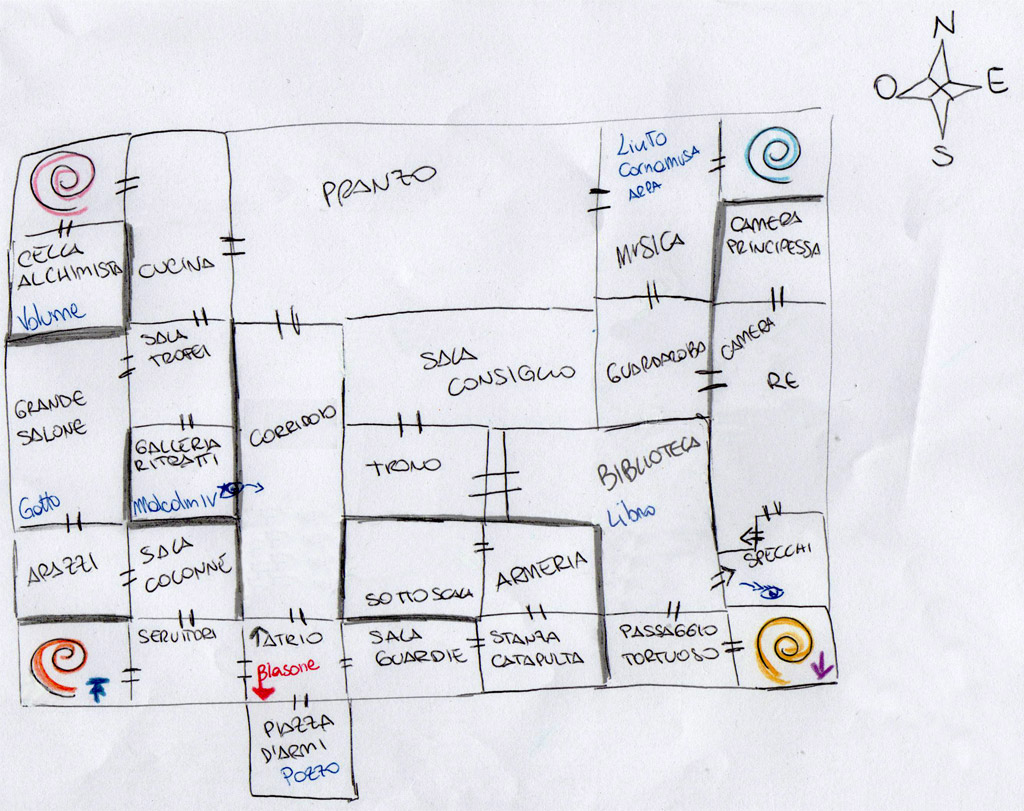
Ground floor, from Oldgamesitalia. Includes some new rooms which I’ll be talking about.
Before getting to that, let me talk about my waste of time. Specifically, I decided to try mapping the maze, which I last time described as absolutely classical, but no:
What are you going to do? DROP LUTE
Paths of a twisted gravity snake away in front and behind.
You are in the maze.
If you drop an item for mapping purposes, it goes away to the start of the maze. The start of the maze is the only room that has a unique room description. This means, for many purposes, the maze would be unmappable, but I decided to at least test the exits of all four directions from the start, just to see if there was an immediate route back that could be used to distinguish some of the maze rooms from each other. Here’s a map part-way through the process:

Notice I have two rooms marked in blue; those two were “indistinguishable” based on the information I had at that moment; going north in both cases leads back to the entrance, and I couldn’t tell if they were two separate rooms or both the same room. I also had a few “second step” rooms tossed in there; while I didn’t have a “return exit” for going west from the entrance, I knew going north and then east would return to the entrance, so I wanted to put that information in.
I might have eventually still given up, except I had a breakthrough later here:
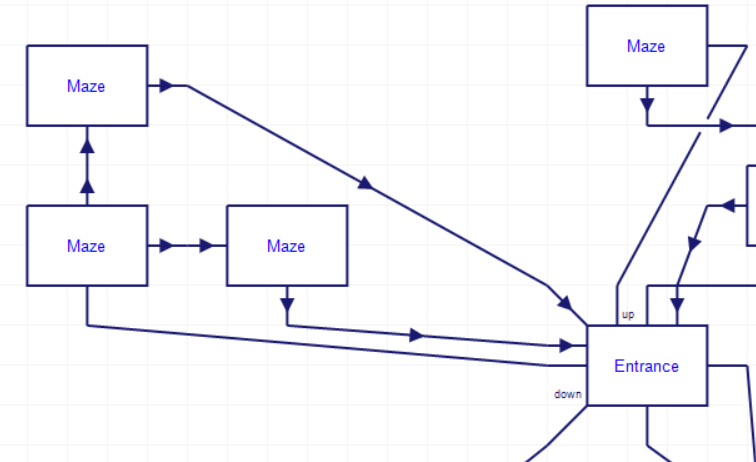
I found that going east and then heading south from the room to the west of the entrance would return back to the entrance. It occurred to me the exact same effect could happen with a loop — that is, a room exit that just goes back to the room itself — so I tried assuming it was a loop, and testing the loop once, twice, three times, and four times; that mean that the probably (nothing here is guaranteed) that I was in fact simply looping back to the same room over and over.

The loops were enough for me to start telling the rooms apart, and filling in the rest of the maze, consolidating rooms I knew to be the same.

Now, the grand effect of this was to find a maze with nothing! So either I did something wrong or there’s a gimmick later; I think I’ve found the clue for the gimmick, and it is the sort of thing that doesn’t work until you know about it. I’ll come back to it later. That means this was all likely a “peek behind the programmer curtain” moment; we weren’t supposed to have been able to map this at all, and the maze without the gimmick wasn’t designed with a solution in mind. (Another related moment happened back when we were playing Ferret; we had used the bolt from a weapon dropping as a room marker for mapping purposes, and discovered there was only one “room”. This was a bug because the desert was supposed to swallow up everything dropped. The single room was simply a mechanic to allow a giant desert without having to implement one, so the system could re-use the same place and change the player’s “coordinate”.)
So, with the maze being useless, I plodded around back in the castle proper, and finally poked at some hints, as I was getting especially frustrated at the basement section, which seemed unresponsive to anything I tried.
You are in the castle dungeon, once called ‘The Tomb’. The floor is covered in skeletons.
I can see a hole on the wall.
Trying to EXAMINE SKELETONS gets “It is our common fate. But can’t you think of something happier?” and SEARCH SKELETONS gets “He who seeks finds.” (The latter seems to be standard for typing SEARCH anywhere.) So I assumed I was supposed to be bringing in an outside item, but no: you’re supposed to pick up a bone even though it isn’t described in the room. (The narrator promised it wouldn’t have any more undescribed objects! Naughty!)
With the bone in you can use it to push the button in the hole without having it slice your hand off.
What are you going to do? INSERT BONE
A blade comes down sharply, slicing the bone cleanly in two. Lucky it wasn’t your arm!
A crack slowly widens…..
This leads over to another room with a “studded bludgeon” and then an exit back to the ground floor of the castle. I have yet to put the bludgeon to any use.
While I was mid-way through typing this post out Matt W. managed to figure out the puzzle in the comments, and he had an extra comment worth highlighting:
I remember when Marco Innocenti submitted the first Andromeda game to the IFComp there was a bit of discussion about how the Italian IF scene tended more toward elaborate descriptions and intuitive leaps in the puzzles than the English-speaking parser scene, which led to some agita when some players got stuck early. The unmentioned parachute reminded me of that, though it’s very fairly clued by the try-and-die and doesn’t waste any of your time since it’s the first move.
After some more struggle (and let’s be honest, some loss of trust in the game after the bone puzzle) I decided to peek at what to do next. This was a little fairer, as I missed examining something:
What are you going to do? LOOK
You are in a long room with a high-arched ceiling supported by two rows of tall columns. The columns, though eroded by time, still bear the signs of patient workmanship by skilled masons. In the centre of the room, a shorter stone pillar rests on a low pedestal.
I had already tried to examine the columns with no luck, and mentally I thought that meant I covered the “shorter stone pillar”, but no, that thing is a PILLAR, not a COLUMN.
What are you going to do? EXAMINE PILLAR
On the capital of the pillar is an engraving, bearing, in silvery metallic letters, half of a powerful magical word: ‘ID’
Fair enough. The game being explicit about it being half a word means it immediately occurred to me the other half was the page from the library I had already discovered (“IOT”, making the word either “IOTID” or “IDIOT”). In case you’re curious, the same joke happens in Italian, as “idiota” is the word for “idiot” so the magic fragments are “id” and “iota”. Either way, you put them together backwards:
What are you going to do? IOTID
The sound of the magic word echoes among the ancient vaults…
An entire wall of shelves rotates on itself. I glimpse a large room.
You’re in the library.
I can see a book on the lectern.
This opens up a throne room.
You’re in the ancient throne room, where the Laird used to administer justice and receive subjects. At the sides of the room are two rows of niches where the Laird’s personal guards stood. The imposing wooden throne is finely crafted, down to the smallest details. In front of the throne is a walled-up door, which must have once been the main entrance from the hallway.
The throne has an uncomfortable cushion, where you can discovered a wooden box underneath. You can find a scroll in a language you can’t read in the box, but take it back to the library and the book, which turns out to be a Gaelic dictionary, and TRANSLATE SCROLL WITH BOOK.
What are you going to do? READ BOOK
It’s a dictionary of ancient Gaelic.
What are you going to do? TRANSLATE SCROLL WITH BOOK
It says:
‘Only by the good use of sense will you find your way out from the labyrinth’
I had incidentally tried to do LISTEN while in the maze already (there’s a sound of chains, but it always comes off the same — at least prior to reading this clue). I still intend to go back there, but I haven’t made it yet as I got distracted by another magical word.
You are in the war room, where all the most serious and important decisions were made. In terms of furniture, there’s a round table surrounded by eight chairs.
What are you going to do? EXAMINE TABLE
A wise maxim is engraved on the edge of the table: ‘Not all swords wound with their blades’
(Not this bit — I don’t actually know what it goes to, but since it’s right next to the Throne Room I thought I’d mention it now.)
No, it turns out — again poking at hints — you can take the bagpipes from the music room over to the book with human skin, and play the bagpipes in order to open the book. I have no idea why you’d do this. (The Italian intuitive solution thing again, I guess?)
You are in the Alchemist’s cell. All around are crucibles, pestles, copper stills and bizarre glass containers of extremely contorted shapes. On the shelves are many heavy tomes of magic, alchemy and spells. In the centre of the room is a small table that rests on three legs shaped like the paws of some monstrous animal. On the table is a single heavy volume bound in black leather:
“The Sorcerer’s Apprentice”
What are you going to do? PLAY BAGPIPES
The volume opens to a page carrying a finely decorated bookmark.
The page gives us the magic word BIGMEOW.
You may recall I already found a cat (who I was able to pick up via the use of milk). BIGMEOW causes the cat to get huge and to eat us.
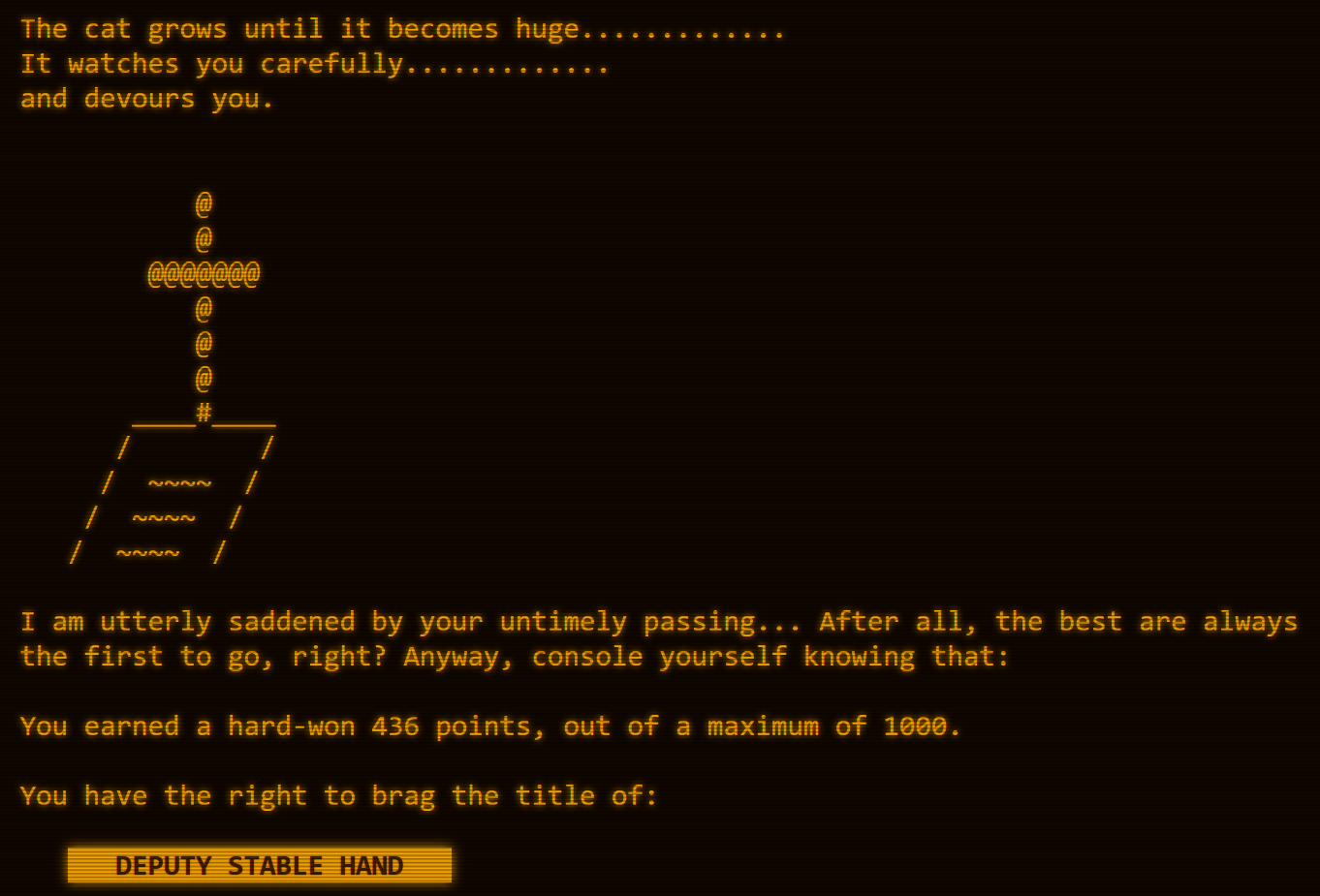
The ASCII art is also in the original.
So hungry cat needs a target, eh? Well, there’s one more place that I also extracted via hints. I had thought (after testing twice) that the spiral staircases leading to ramparts only led up — all four have the same room description, too — but the one in the southeast, and only in the southeast, also goes down.
What are you going to do? D
You are in a room with a spiral staircase.
What are you going to do? D
You’re in a room with a spiral staircase, and a narrow passageway to the north.
What are you going to do? N
You’re walking along a large tunnel carved into the rock that forms the
foundations of the castle.
I can see a ferocious ogre with sharp fangs.
What are you going to do? BIGMEOW
The cat grows until it becomes huge………….
It watches you carefully………….
observe the ogre carefully……….
The cat devours the ogre and dies of indigestion.
Again, not terribly fair, but I’m still taking this moment to do a “reset” since I’m a little more than halfway through the game (based on the score) and try to avoid hints for a bit longer. Some of the issue is simply vibing with the unwritten rules (like how the “pillar” is part of the main room description paragraph but still important, or the bone can be there and not mentioned even when you try to look, or the extra-down-exit trick, or the arbitrary bagpipe location) so perhaps the back end of this will go a little smoother than the front half.
No guarantees, though!
I have finished the game. You can read all my entries in order here.
I should preface a little, for the benefit of those who normally don’t read this blog and are here just for this game: this isn’t really a “review blog”, even though you can interpret what I write that way. I’m trying to understand the full span of adventure games, and extract what knowledge I can and place it in historical context. That means some elements of a game may be bad choices, but serve a purpose, or at the very least be “good enough” in a particular setting.
This game was extremely important for Italy, and it had wide enough commercial spread it was some people’s first adventure, or even first computer game of any kind. In this interview with the author from only two weeks ago, in addition to the live comments, there’s this top comment that attests to lasting influence:
Mi sono appassionato alla programmazione proprio grazie ad Avventura nel Castello che giocavo rigorosamente al buio con i miei cugini su un M19. Oggi è il mio lavoro e la mia passione! GRAZIE
I got into my passion for programming specifically because of Avventura nel Castello, which I used to play only in the dark with my cousins using a M19. Today it is both my job and my passion. Thank you!
(M19 refers to the Olivetti M19; Olivetti was one of the big local computer manufacturers; they had started out in typewriters.)
If the game is treated as a place to visit (where you don’t necessarily care about winning) it manages a strong atmosphere; the vast majority of the castle can be reached without solving puzzles, and any new areas are small. So I could see someone playing the game off and on over years, maybe getting to a new place just by sheer persistence, meaning my playthrough is not representative of how people responded at the time.
So while I’m going to be a little hard on this, I’m doing it out of love, but also with the presumption it should be a game played from start to finish without large pauses in the middle.
Last time I was hopeful that perhaps I could turn things around and not rely on poking at hints every other puzzle.
cough
No, sorry. Things got even worse. There was one nifty trick remaining, but the rest of the puzzles were mean in some aspect. (One of the mean parts was also wonderfully audacious in its cruelty, but let’s just see it in context.)
Let’s get a reasonable part out of the way first — relatively speaking, you have to refer to a thing in the room description again:
You’re in a short room crammed with hunting and war trophies. Fixed to the walls are stuffed animal head of all kinds, weapons, shields, even an entire suit of armour that probably belonged to a rival clan chief killed in battle by the Laird himself.
What are you going to do? EXAMINE ARMOR
It is the armour of Sir Crawford, the valiant warrior wizard who, for many years, held MacCallum IV in check with his prowess and his fearsome arts. The armour still maintains a haughty bearing, and even seems to stare at you, leaning on the sword.
You’re in the trophy room.
What are you going to do? TAKE SWORD
Done!
“Reasonable” is relatively speaking. This is still referring to a “second-order” object — that is, it’s an object that gets referred to in the description of an object, and you have the realize you can try to go ahead and take it. I had this in my head because with some different suits of armor (back in the main hall of the castle) I killed myself trying to grab a pike:
You’re in a large hallway, the floor of which bears the signs of the passage of countless generations. A row of armour is lined up along the wall, each holding a long pike.
Towards the centre of the hallway, there appears to have once been a door, now bricked up.
What are you going to do? TAKE PIKE
You take the pike and pull it towards you, but the armour doesn’t seem to want to let it go. Should you pull it a wee bit harder ? YES
With a firm tug, you finally manage to get hold of the pike.
The armour, unbalanced, wobbles slightly……
and as you step back with the tip of the pike gripped in your hands, the armour falls with all its weight onto the other end of the weapon, piercing you through and through.
This is how it was used in battle!
So I was at least somewhat prepared to grab the sword. The sword is described as having a “spell” on its blade. You can try to read the spell and the game mysteriously asks if you mean to read it out loud.
What are you going to do? READ SPELL
Should you say it out loud? YES
Nothing is happening.
Back down past the ogre that the cat ate last time there are two things: a dwarf holding a diamond, and a chest. (Both locations are marked on the map below.)
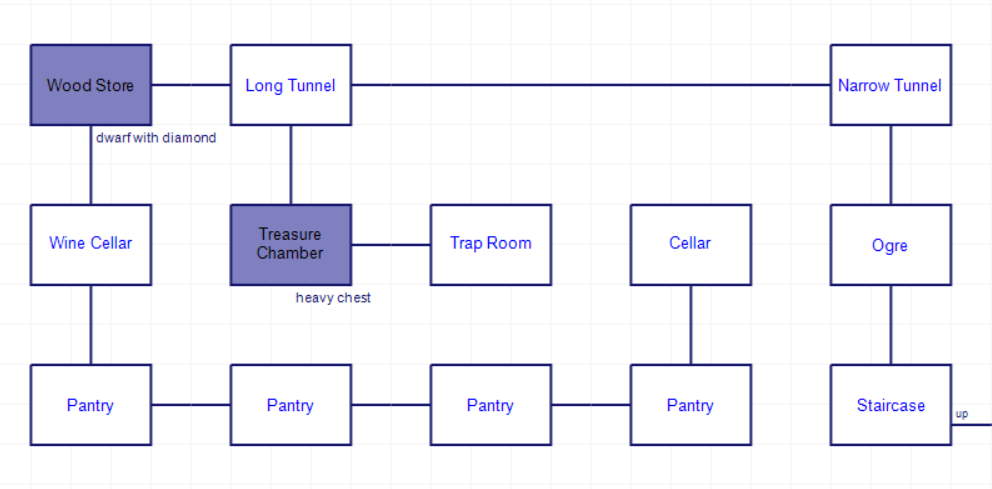
The chest is where the spell goes, and yes, it’s very arbitrary:
What are you going to do? OPEN CHEST
The ghost of Malcolm’s faithful squire, Edgar MacDouglas, rises to defend the treasure of his ancient Laird from the foreign defiler.
You’re in the treasure chamber.
I can see a heavy chest.
I can see a ghost.
Yes, if you go back and look at the sword, and specifically the armor, it seems to be someone who defined the Laird family of the castle, so it makes some sense after the fact that the spell on the sword would help oppose a spirit who identifies with the Lairds. It’s still very after-the-fact reasoning, and made worse by an extra obstacle: when you try to read the spell out loud voice is cracked.
Your throat is dry with fear…
You can’t speak…
The ghost takes advantage of this to attack you.
I very briefly mentioned last time some honey milk I fed to a cat; the cat is takeable without giving over the milk. I had unknowingly soft-locked the game. The milk is supposed to be saved so you can use it on yourself, although you have only one turn, the one immediately before stating the spell.
What are you going to do? DRINK MILK
Lip-lickingly delicious!
What are you going to do? READ SPELL
Should you say it out loud? YES
With a long, desperate wail, the ghost returns to the nothingness from which it came.
The honey is sort of a hint about throat control, but this puzzle was, at the very least, kind of mean. The chest, ghost-free, yields up a hunting horn.
It is decorated with hunting scenes that wrap around in a spiral from its mouth. Galloping riders are seen to chase their prey, while large birds circle overhead.
The one after is as well:
You are in the wood store, where dry branches and logs of various sizes are stacked in perfect order.
I can see a wee dwarf with a big diamond.
What are you going to do? EXAMINE DWARF
He’s quite small.
What are you going to do? EXAMINE DIAMOND
The more you observe the wonderful gemstone, the more you become overwhelmed by an unbridled desire to possess it.
You do need the diamond, but can’t steal it away or defeat the dwarf in combat or anything like that. You’re just supposed to GREET (or in Italian, SALUTA) it:
The dwarf is so happy to finally meet such a courteous person that he simply gives you the diamond.
This is one of those puzzles if you run 20 people through, someone is bound to get it just by trying naturally, but it is hard to work out what the natural thought process for a solution might otherwise be.
The game then rather cheekily warns you to be careful with the newly-acquired diamond:
It’s magnificent: the light reflected and refracted by its a thousand perfect facets creates an infinite play of colour. You are fascinated by it, and would observe it for hours and hours. I think it’s of inestimable value, and you should treat it with utmost care.
However, remember: this is not a treasure hunt! We don’t care about treasures. We care about getting out of the castle. Somehow (…magic?…) the bludgeon from down the basement (the one that required using a bone to get) is able to smash the diamond, and we can then get a key.
On the first blow of the bludgeon, the diamond shatters into a thousand pieces.
Conceptually, I see the point here: the narrator has been a little bit off-kilter since the very first puzzle, so the very strong suggestion to treat the diamond with utmost care can be thought of as giving instructions to do the opposite. That doesn’t stop the puzzle from being amazingly cruel.
The key and the horn are the two items needed to escape. We need to head back to the maze, the one I mentioned last time led to nowhere when I mapped it out, but we got an explicit hint I hadn’t applied yet:
‘Only by the good use of sense will you find your way out from the labyrinth’
This is a puzzle we’ve seen before but somehow the phrasing threw me off here. It works both in Italian and in English, and by making that statement, I’ve given the hint that wordplay is involved.
‘Only by the good use of sense will you find your way out from the labyrinth’
We’re not using “our senses” (as I first read it) we are using the word “sense”, giving the sequence south, east, north, south, east. (Without having read the hint first, this just returns the player to the entrance.)
In Italian, the word is SENNO, which might seem like it breaks, but the Italian word for “west” is “ouest”! So S, E, N, N, O is the solution in that version of the game.
What are you going to do? E
You’re in the large secret room, under the castle tower. A current of icy air
hisses through invisible cracks.
I can see a lever.
I can see a stopped old pendulum clock.
I imagine for people who didn’t ping at the walkthrough for items this puzzle was completely stumped; here, I was just mostly stumped. The key is not the kind of key to unlock things, but the kind of key to wind things. You can WIND the clock, causing it to start ticking. It was close to but not right at midnight, and when it reaches midnight:
A stone block shifts, revealing a spiral staircase.
This leads you to the roof, and once again, you have to make arbitrary use of a magic item.
You’re at the top of the tower, where your gaze sweeps above the fog covering the peatland, and towards the distant mountains.
I can see a flag in tatters.
What are you going to do? TAKE FLAG
The old flagpole evades your grip… and suddenly gives way, making you lose your balance. You fall down onto the parade ground.
(Or you can try fiddling with the flag, but that’s a red herring, it kills you.)
You have to use the horn. Now, we hit the one part where the English version is much harder than the Italian version. You would think to BLOW HORN, but no, that verb is not understood. I was completely baffled and checked the required verb in Italian, which is SUONA, which I’d still translate (in the context of using the word on a horn in English) to “BLOW”. But they (Adam Bishop, the translator) translated it to SOUND, like SOUND HORN. This is the first time I’ve had that as a required verb in an adventure game, and it may be the only time I ever see it. Yes, it technically is grammatical, but more along the lines of terminology from a prior century.
What are you going to do? SOUND HORN
The ancient horn sounds across the moor, echoing off the distant mountains. A black dot rises from the mountains and grows larger as it approaches. Quickly it reaches the tower: it’s a large golden eagle that lurches towards you with its claws extended.
What are you going to do?
This is a fake-out; you can’t type anything before being interrupted. Oh also, you needed the parachute here, otherwise you die; theoretically an easy puzzle to resolve after dying once, but someone might have dumped their parachute back in the first room where it would be inaccessible and have to restart the whole game.
You have no chance:
The eagle grabs you, quickly lifting you up to a great height.
The eagle flies for a long time while the landscape races beneath you… … … … … … … … … … … … . .. … … … … … … … … … … … … … … … … …Loch Ness appears in the distance… … … … … … … … … … … … … . .. … … … … … … … … … … … … … … … … …Suddenly, the eagle lets go of you.
You gently descend in the dying daylight. Below you are the dark waters of Loch Ness. The wind pushes you towards the centre of the lake. By chance, you land on a small outcrop of rock.
While you fold away your parachute, you look around:
You’re alone and abandoned on a black rock peaking above the icy waters. Let me correct myself, you are not alone: the Loch Ness Monster (Nessie among friends) is there to keep you company.
The Loch Ness Monster is not trying to be your friend.
Arbitrary magic is your friend again. This is solvable in a “well, there’s nothing else I can do” sense but not in a logical sense.
The ancient horn sounds across the moor, echoing off the distant mountains. A black dot rises from the mountains and grows larger as it approaches. Quickly it reaches the rock: it’s a helicopter from the Royal Archaeological Service, which throws you down a rescue ladder. You climb the ladder as the monster’s jaws snap shut inches below you.
You are informed the horn is Malcolm the Fourth’s thought to be worth “a million pounds or more”, but upon landing we get charged with crimes.

At least the game compensates you with what I think is the best title for winning a game I’ve ever heard.
Anyhow, console yourself: you have finally earned the 1000 points that give you the right to boast the coveted title of:
THE DEVIL’S LIEUTENANT!!!
Look: I loved original Adventure as a child, but I never came close to beating it. I was able to explore most of it — even the part past the plant, which was one of the easier puzzles — and while I didn’t solve the golden eggs puzzle until I was a grown adult (so had to sacrifice treasure at the troll) I still had a grand time and have many core memories exploring the dense caverns. Similarly, while I’m sure someone will chime in they somehow solved this game without help, I’m guessing a lot of the people this game influenced treated Castle Adventure as a destination to explore, with the fact there were unplumbed secrets making something of a bonus.
And certainly: the text has a great sense of attitude, both in the Italian original and the relatively literal translation. The deaths were amusing and while the softlocks were terrible they weren’t overwhelming either; you also don’t have to bother with a light timer like so many Adventure clones felt obligated to include.
So while I only recommend this for the historically curious (English version here) I’m glad that it exists.
